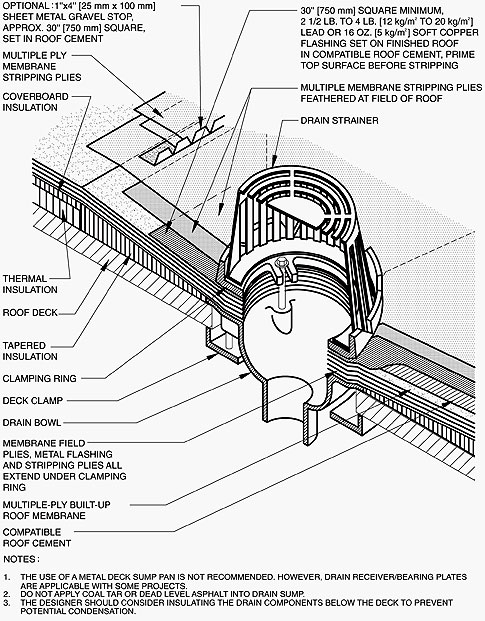The isometric roof drain detail shown here is known as an interior drain detail because it always is used within the field of a built-up roof (BUR) system and drainage is directed to the interior of the roof area.
A typical interior roof drain assembly occupies about a 4- by 4-foot (1.2- by 1.2-m) square area or about the area of one piece of insulation board. Drains should be located in square-shaped, gradually tapered sumps formed in the insulation to facilitate localized drainage at drains. Round or deeply recessed, sharply sloped sumps are not recommended because they can create wrinkling of a built-up membrane.
NRCA does not recommend metal sump pans unless the risk of condensation on the metal surfaces recessed below the insulation can be prevented and the membrane can be installed into the pan without wrinkling.
Tapered board insulation is field-fabricated to ensure positive slope to drain and installed on top of the structural deck. The BUR membrane then is installed over the tapered insulation into the roof drain bowl. To ensure the ply felts lay flat, you may have to carefully slit the felts so they conform to the taper. It is advised to protect the drain bowl assembly from bitumen buildup by installing a plug or damming up the assembly before a BUR membrane is installed. (Be sure to remove the drain plug or dam at the end of each day.)

Detail BUR-20 from The NRCA Roofing and Waterproofing Manual, Fifth Edition
A 30-inch (762-mm) square minimum 2 1/2- to 4-pound or 16-ounce soft copper flashing (primed on both sides) is set on the finished BUR membrane in compatible roof cement. The soft metal flashing should be preformed over the finished BUR membrane before setting it in roof cement to ensure the metal flashing conforms to the tapered surface.
Stripping plies are installed over the soft metal flashing and feathered into the roof's field.
A notched 1- by 4-inch (25- by 102-mm) sheet-metal gravel stop minimum 30-inch (762-mm) square can be installed over the completed roof drain assembly to prevent gravel and bitumen migration into the roof drain.
The clamping ring then is installed over the completed roof drain assembly, and the drain strainer is set on the drain bowl assembly to complete the roof drain installation.
Chuck Scislo is an NRCA senior director of technical services.
COMMENTS
Be the first to comment. Please log in to leave a comment.